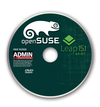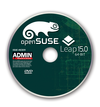
An exclusive interview with openSUSE Chairman Richard Brown
Leaping into the Future
At SUSECON, Richard Brown and I discussed a variety of topics, including the adoption or rejection of the two versions of openSUSE: Leap and Tumbleweed. We also discussed openSUSE's relationship with the desktop environment and arrival of openSUSE to Raspberry Pi 3.
ADMIN magazine: It's been a year now since openSUSE made a leap by moving its base to SUSE Linux Enterprise SP1 with the release of openSUSE Leap 42.1. How has the feedback been?
Richard Brown: The release of Leap went according to plan in many respects. We got it out on time; we got it on schedule; the quality was right where we wanted it to be. The engagement from the community was great and on point. We wanted the adoption by users, and downloads were exactly where we'd hoped them to be. Especially with going for a more conservative audience, there was always a little bit of concern of "are we going to have a little bit of a drop-off of our user base?" But the adoption rates were exactly where we expected [them] to be; it is more conservative. It wasn't like an astronomical growth that we've seen with Tumbleweed, but it was healthy.
ADMIN: What effect did it have on SLES?
RB: Everything was as expected, with some interesting things along the journey that I wasn't expecting. Obviously SUSE was to use this as a way of establishing more communication with the community and engagement there. That all worked out fine. One thing that's come across that we weren't expecting was actually more engagement from SUSE's customers and partners with SUSE and openSUSE through Leap. There were cases where companies like IBM were contributing directly to openSUSE, because they know that's going to be reflected in the SLE side of things and that makes their lives easy.
ADMIN: It's a complicated
...Buy this article as PDF
(incl. VAT)
Buy ADMIN Magazine
Subscribe to our ADMIN Newsletters
Subscribe to our Linux Newsletters
Find Linux and Open Source Jobs
Most Popular
Support Our Work
ADMIN content is made possible with support from readers like you. Please consider contributing when you've found an article to be beneficial.





